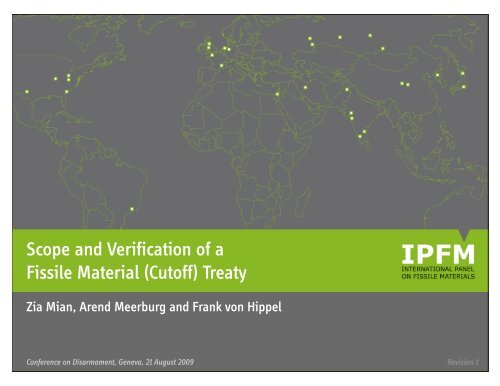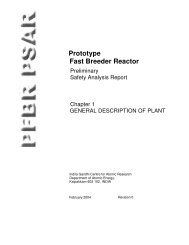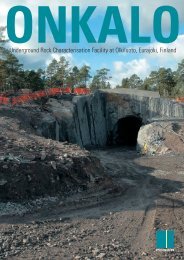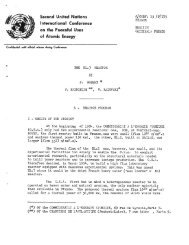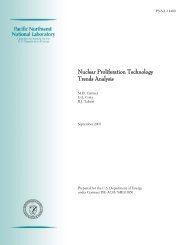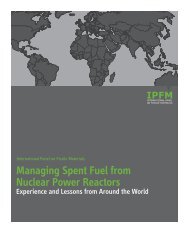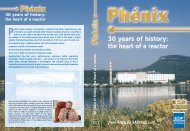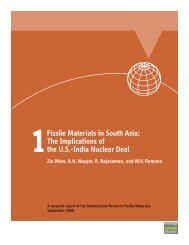Scope and Verification of a Fissile Material (Cutoff) Treaty
Scope and Verification of a Fissile Material (Cutoff) Treaty
Scope and Verification of a Fissile Material (Cutoff) Treaty
- No tags were found...
You also want an ePaper? Increase the reach of your titles
YUMPU automatically turns print PDFs into web optimized ePapers that Google loves.
<strong>Scope</strong> <strong>and</strong> <strong>Verification</strong> <strong>of</strong> a<strong>Fissile</strong> <strong>Material</strong> (Cut<strong>of</strong>f) <strong>Treaty</strong>Zia Mian, Arend Meerburg <strong>and</strong> Frank von HippelConference on Disarmament, Geneva, 21 August 2009 Revision 1
OutlineAbout the IPFMGlobal stocks <strong>of</strong> fissile material -- Zia MianFM(C)T design choices -- Arend Meerburg<strong>Verification</strong> issues -- Frank von Hippel
About IPFMEstablished in January 2006 with MacArthur Foundation 5-year grantMISSIONTo provide the technical basis for policy initiatives to consolidate,<strong>and</strong> reduce stockpiles <strong>of</strong> HEU <strong>and</strong> plutonium <strong>and</strong> thereby help:•Achieve irreversible nuclear-warhead reductions,•Strengthen the nonproliferation regime, <strong>and</strong>•Reduce dangers <strong>of</strong> nuclear terrorismConference on Disarmament, Geneva, 21 August 2009
24 Members from 17 States7 Weapon States 10 Non-weapon States• James Acton (UK)• Anatoli Diakov (Moscow, Russia)• Pervez Hoodbhoy (Islamabad, Pakistan)• Li Bin (Beijing, China)• Yves Marignac (Paris, France)• Abdul H. Nayyar (Islamabad, Pakistan)• Pavel Podvig (Russia)• R. Rajaraman (Co-Chair, New Delhi, India)• M. V. Ramana (Bangalore, India)• Mycle Schneider (Paris, France)• Shen Dingli (Shanghai, China)• Frank von Hippel (Co-Chair, Princeton, USA)• William Walker (St. Andrews, UK)• Jean DuPreez (South Africa)• José Goldemberg (São Paolo, Brazil)• Martin B. Kalinowski (Hamburg, Germany)• Jungmin Kang (Seoul, South Korea)• Patricia Lewis (Irel<strong>and</strong>)• Miguel Marín-Bosch (Mexico City, Mexico)• Arend Meerburg (Den Haag, Netherl<strong>and</strong>s)• Henrik Sal<strong>and</strong>er (Stockholm, Sweden)• Ole Reistad (Olso, Norway)• Annette Schaper (Frankfurt, Germany)• Tatsujiro Suzuki (Tokyo, Japan)Princeton University ResearchersHarold FeivesonZia MianAlex<strong>and</strong>er GlaserConference on Disarmament, Geneva, 21 August 2009
<strong>Fissile</strong> <strong>Material</strong> (Cut<strong>of</strong>f) <strong>Treaty</strong>Global Stocks <strong>of</strong> <strong>Fissile</strong> <strong>Material</strong>s, 2008Zia MianPrinceton UniversityConference on Disarmament, Geneva 21 August 2009
<strong>Fissile</strong> <strong>Material</strong>s <strong>and</strong> Nuclear Weapons<strong>Material</strong> that can sustain an explosive fission chain reactionnotably highly enriched uranium or plutonium (<strong>of</strong> almost any isotopic composition)Conference on Disarmament, Geneva 21 August 2009
Modern Thermonuclear WarheadA modern thermonuclear warhead may contain both plutonium <strong>and</strong> highly enriched uranium(Average estimated values are 4 kg <strong>and</strong> 25 kg <strong>of</strong> plutonium <strong>and</strong> HEU, respectively)Conference on Disarmament, Geneva, 21 August 2009
Nuclear Arsenals, 2009(based on estimates by NRDC/FAS)CountryUnited StatesRussiaNuclear Warheadsabout 10,000(5000 deployed + 5000 awaiting dismantlement)about 10,000(large uncertainty as to number awaiting dismantlement)France fewer than 300United Kingdom 185China about 240Israel 100-200Pakistan about 60India about 60North Korea fewer than 5Conference on Disarmament, Geneva 21 August 2009
HEU Stockpiles, 2008Global stockpile is almost 1700 tons, over 99% is in weapon statesConference on Disarmament, Geneva, 21 August 2009
HEU Consumption in Naval Vessels**”HEU Fuel Cycle Inventories <strong>and</strong> Progress on Global Minimization,”Ole Reistad <strong>and</strong> Styrkaar Hustveit,Nonproliferation Review, 15:2, (2008) p. 265.Conference on Disarmament, Geneva, 21 August 2009
The Naval HEU Problemin a Disarming WorldConference on Disarmament, Geneva, 21 August 2009
Plutonium Stockpiles, 2008Global stockpile is 500 tons, half is civilian <strong>and</strong> this stock is growingConference on Disarmament, Geneva, 21 August 2009
The Civilian Plutonium Problemin a Disarming WorldConference on Disarmament, Geneva, 21 August 2009
<strong>Fissile</strong> <strong>Material</strong> (Cut<strong>of</strong>f) <strong>Treaty</strong>Design ChoicesArend MeerburgConference on Disarmament, Geneva, 21 August 2009
Design Recommendations for an FM(C)TShould be verified: essential in a disarming worldBy the IAEA (already trained <strong>and</strong> equipped to do the task)Like the NPT, no detailed verification provisions in the<strong>Treaty</strong> since IAEA has the mechanisms to developappropriate verification measures<strong>Treaty</strong> should prohibit the production <strong>of</strong> all fissilematerials (plutonium Pu, highly enriched uranium HEU...)for use in nuclear weaponsProduction facilities should be closed <strong>and</strong> dismantled orused for civilian or non-explosive military purposes.Production facilities are reprocessing plants (separating Pufrom spent radioactive fuel) <strong>and</strong> uranium enrichmentfacilities.
Four categories <strong>of</strong> stocks <strong>of</strong> fissile materials1. <strong>Fissile</strong> materials in or for weapons2. <strong>Fissile</strong> materials for civilian purposes3. <strong>Fissile</strong> materials declared as excess for military/explosivepurposes4. <strong>Fissile</strong> materials in or for military reactors (navalpropulsion, tritium production)Category 1 is directly related to nuclear disarmamentagreements.FM(C)T should cover categories 2-4 which should never beused for weapons : a one-way street to safeguards
CoverageAll production <strong>and</strong> use <strong>of</strong> civilian fissile materialsafter entry into force should be safeguarded.All existing civilian fissile material also should besafeguardedAll material declared as excess for weapons shouldbe brought under safeguards (if necessary afterconversion to unclassified form)Military non-explosive materials (e.g. naval HEU)should not be used for weapons
<strong>Verification</strong> ProtocolsNon-nuclear-weapon States with a comprehensivesafeguards agreement <strong>and</strong> an AdditionalProtocol have no further obligations (but mustmake special arrangements for use <strong>of</strong> fissilematerials in naval propulsion <strong>and</strong> whenproducing or using neptunium <strong>and</strong>/or americium)Other (weapon) states need to make specialagreements with the IAEAThis approach would bring convergence betweenthe basic safeguards obligations <strong>of</strong> nuclearweaponstates <strong>and</strong> non-weapon states
A Conference <strong>of</strong> States Parties (CSP)Since the IAEA Board <strong>of</strong> Governors must report tothe Security Council in the case <strong>of</strong> a safeguardsviolation<strong>and</strong> a State with veto power in the SCcould be involved, a CSP is needed to h<strong>and</strong>lesuch a case (see also CWC <strong>and</strong> CTBT)However: what about the relation with the IAEA?What about the financing for the extra safeguards?
Entry into Force (EiF)An FM(C)T is relevant primarily for those 8 or 9States with significant quantities <strong>of</strong> fissilematerials not subject to internationalsafeguards.It would not be wise to dem<strong>and</strong> ratification by allthose States for EiF. Better to start with the<strong>Treaty</strong> quickly <strong>and</strong> get experience with theapplication <strong>of</strong> the safeguards, <strong>and</strong> have aserious review after, say, ten years.
<strong>Fissile</strong> <strong>Material</strong> (Cut<strong>of</strong>f) <strong>Treaty</strong><strong>Verification</strong> ChallengesFrank von HippelPrinceton UniversityConference on Disarmament, Geneva, 21 August 2009
<strong>Verification</strong> Challenges1. Shutdown facilities2. Enrichment plants3. Reprocessing plants4. Managed access to military nuclear sites5. Weapon-origin fissile material6. HEU in Naval-reactor fuel cyclePrecedents for verification exist in NPT safeguardsin non-weapon states but some important difference.Conference on Disarmament, Geneva, 21 August 2009
1: Shutdown FacilitiesLargest HEU <strong>and</strong> plutonium production facilities have been shut downor converted to non-weapons purposes for at least a decade.Easy to verify that they have been disabled: Put seals on key equipment,remotely monitor key areas, <strong>and</strong> make periodic short onsite checks.End <strong>of</strong> Weapons Pu ProdEnd <strong>of</strong> Military HEU ProdChinaFrance1991 1987-891994 1996IndiacontinuingcontinuingIsraelNorth Koreacontinuing ??continuing ?PakistancontinuingcontinuingRussia1995 1987-88United Kingdom1989 1963United States 1988 1992**1964 for weaponsConference on Disarmament, Geneva, 21 August 2009
2: Enrichment PlantsMany centrifuge enrichment facilities in weapon states alreadyunder or <strong>of</strong>fered for international safeguards.Country Facility Safeguards Status Capacity [tSWU/yr]Non-weaponstatesBrazil Resende YesGermany Gronau YesIran Natanz YesJapan Rokkasho YesThe Netherl<strong>and</strong>s Almelo YesFrance George Besse II (Yes)U.K. Capenhurst Yes1204,5002501,0503,500under construction4,000Piketon, Ohio<strong>of</strong>feredunder constructionUnited StatesEunice, NM <strong>of</strong>feredunder constructionWeapon statesChinaAreva, IdahoShaanxiLanzhou IIAngarsk II(<strong>of</strong>fered)(Yes)<strong>of</strong>fered(<strong>of</strong>fered)under construction1,000500proposedRussiaAngarsk INovouralskSeverskZelenogorskNoabout30,000India Rattehalli NoPakistan Kahuta No4-1015-20Conference on Disarmament, Geneva, 21 August 2009*after planned expansions are complete
New challenge: For enrichment plants that produced HEU in the past,would have to be able to determine if HEU particles are pre FM(C)TNovouralsk, Russia
3. Reprocessing Plants -- by far the most costly facilities to safeguard(Rokkasho, only full-scale reprocessing plant in a non-weaponstate, under IAEA Safeguards)Major producer <strong>of</strong> fissilematerial: 1000 weaponequivalents <strong>of</strong> plutonium willbe separated each year.Costly safeguards: Japan’s tworeprocessing plants absorbabout 20% <strong>of</strong> the IAEAsafeguards budget.A modernized lower-costapproach for alreadyoperating plants in weaponstates: Former IAEA expertwho supervised thesafeguards for Rokkasho hasdesigned a system that wouldcost about 1/6 as much.Conference on Disarmament, Geneva, 21 August 2009
4. Challenge Inspections at Military Nuclear Sites: Managed Access PrecedentsAdditional Protocolin non-weapon statesFM(C)T inweapon statesChemical WeaponsConventionanywhereMilitarynuclear sitesFacilities that have analoguesin non-weapon statesanywherein weapon <strong>and</strong>non-weapon statesIssue is nuclear activities at nuclear sites.Select sensors to reveal enrichment or reprocessing but not sensitive weapon or fuel-related informationManaged access under the U.S.-IAEA Additional ProtocolLimited by a national-security exclusion but only Department <strong>of</strong> Defense invoked blanket exemption.U.S. Nuclear Regulatory Commission has required its licensees <strong>and</strong> Department <strong>of</strong> Energy many <strong>of</strong> itsfacilities to plan for IAEA managed access (list was published)Conference on Disarmament, Geneva, 21 August 2009
5. Non-Diversion <strong>of</strong> <strong>Material</strong> Declared Excess for Weapon Purposes(while in classified form)1996-2002 Trilateral (IAEA-Russia-US) Initiative developed approach to check thata container holds more than a threshold amount <strong>of</strong> weapon-grade plutoniumplutonium ?weapon-grade ?more than x kg ?“Attribute <strong>Verification</strong> System” (AVNG)incl. Neutron <strong>and</strong> Gamma DetectorResults communicated by red or green lightsthrough information barrierIPFM is working on corresponding approachfor HEU componentsContainer withclassified plutoniumcomponentConference on Disarmament, Geneva, 21 August 2009
6. Non-diversion <strong>of</strong> HEU in the Naval Fuel CycleUnited States, Russia, United Kingdom <strong>and</strong> India all use HEU to fuel naval vessels(mostly submarines; the U.S. <strong>and</strong> U.K. vessels are fueled with weapon-grade uranium)France has switched to LEU (China unknown)SSN-774 Virginia-class (NSSN New Attack Submarine)Source: U.S. NavyConference on Disarmament, Geneva, 21 August 2009
Tracking HEU in the naval-reactor fuel cycleMonitored HEU stockpileDeclared quantity <strong>of</strong> HEU meteredout to fuel-fabrication facilityFuel fabrication facilityAmount <strong>of</strong> HEU in fabricated fuelverifiedContainer holdingfabricated fuelFueled reactorin vesselInstallation in reactor might beverified non-intrusivelyConference on Disarmament, Geneva, 21 August 2009
Overall Conclusions1. The technical challenges <strong>of</strong> verifying an FM(C)T are significantbut probably not as difficult asthe political challenges <strong>of</strong> negotiating it2. The costs <strong>of</strong> FM(C)T verification could beless than the current IAEA safeguards budgetConference on Disarmament, Geneva, 21 August 2009
<strong>Fissile</strong> <strong>Material</strong> (Cut<strong>of</strong>f) <strong>Treaty</strong><strong>Scope</strong> <strong>and</strong> <strong>Verification</strong>Conference on Disarmament, Geneva, 2009


